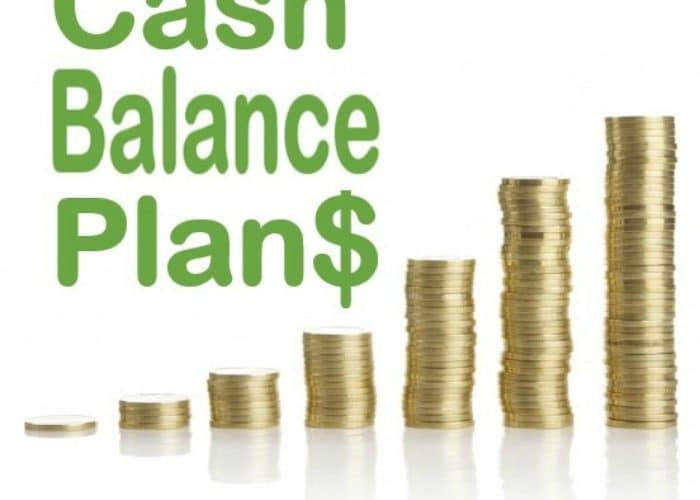When it comes to retirement options, there is no such thing as a one-size-fits-all approach. There are numerous plans available for retirement, each with its own set of advantages and disadvantages. But one thing is certain: the cash balance plan is an often ignored solution for retirement. If a company owner has no (or just a few) employees, there are a couple of excellent options. When it comes to minimum and maximum donations, people become perplexed. They just want to know what the annual contribution limits and lifetime limits for cash balance plans are.
Many of these funding concerns will be addressed in this article.
What Is a Cash Balance Plan?
In a cash balance contract, a participating employee is advised that when he or she retires, he or she will have access to a certain number. Assume the number is $400,000. The proposal assumes a mix of employer contributions and compounds interest over time to reach the $400,000 target.
When the employee retires, she has the option of taking the $400,000 as a lump sum or committing to an annuity that pays a portion of the $400,000 in monthly payments. Every year that an employee receives benefits with a business, she accrues benefits using the formula: Annual benefit = (wage x salary credit rate) + (account balance x interest credit rate).
Let’s dissect those words. The pay of an employee is his or her salary. The compensation credit rate is the amount of an employee’s salary that the employer contributes. This is typically between 5% and 8%.
The account balance is the sum of benefits and wages that the employee has already accumulated. The interest credit rate is a percentage set by the employer to increase payments over time. This may be a fixed rate (5 percent, for example) or a variable rate tied to something else, such as the interest rate on 30-year Treasury bonds.
Traditional Pension vs. Cash Balance
When some businesses and state governments started changing their conventional pension schemes to cash balance plans as an alternative to freezing troubled pensions, cash balance plans gained popularity. If you’ve recently learned that your pension will be converted to a cash balance account, here’s what you need to know:
- The benefits you’ve already accrued are (most likely) secure:
Companies may adjust or freeze pension plans while they are still in business, but they cannot renege on benefits that their workers have already received. And if the terms of the employer-sponsored contract deteriorate, you will always be able to access the benefits you earned under the initial plan. Furthermore, the bulk of assets in most defined benefit programs are federally guaranteed by the Pension Benefit Guaranty Corporation, a government agency.
- Conversion to a cash flow plan benefits younger workers more:
A standard pension measures your retirement benefits based on a calculation that takes into account your time with the corporation and your income in the last few years of work. If you’re an accomplished worker who has risen through the ranks and is now making a good living, it’s probably in your best interests to have a pension that represents your income growth.
Cash balance contracts, on the other hand, have incentives that are distributed more uniformly over the course of a worker’s career and rise at the same rate over time. Contributions made early in a worker’s career have more time to compound and therefore are more important.
What are the Cash Balance Plan’s Limits?
The annual contribution is usually not set and can increase or decrease depending on several factors.
The aim is to produce a certain amount of money when you reach retirement age. A cash balance plan is essentially planning for a retirement sum in the future.
This is not the case for a 401(k).
A cash balance plan, unlike a 401(k), does not have an annual contribution limit (k). This is because it is attempting to hit a certain sum upon retirement (typically at 62 years old).
The amount of money in the cash balance plan at retirement is determined by several factors. However, it is primarily determined by the annual salary. Assuming full salary, you will retire with approximately $2.9 million. A sizable sum of money.
IRS Limit for Cash Balance plans (Annual Contribution Limits) 2023
One often asked question is, “How much can I contribute to a cash balance plan?” What is the IRS exemption limit?
In theory, there is no annual contribution cap for a cash balance account. Instead, the ultimate benefit payable at retirement is limited.
So, assuming full payout, reported mortality rates, and a 5% interest rate credit (fairly standard), we can calculate an approximate annual contribution cap for a given age.
But be cautious. These contribution levels are merely examples; real sums are determined by an actuary. The IRS cap is also normally indexed on an annual basis.
Cash Balance Plan Annual Contribution Limit Table
| Age | Maximum Annual Contribution |
| 40 | $138,158 |
| 41 | $143,162 |
| 42 | $148,348 |
| 43 | $153,721 |
| 44 | $159,289 |
| 45 | $165,058 |
| 46 | $174,590 |
| 47 | $184,672 |
| 48 | $195,336 |
| 49 | $206,616 |
| 50 | $218,547 |
| 51 | $225,747 |
| 52 | $233,184 |
| 53 | $240,867 |
| 54 | $248,802 |
| 55 | $256,999 |
| 56 | $272,106 |
| 57 | $288,100 |
| 58 | $305,035 |
| 59 | $322,965 |
| 60 | $316,183 |
Beginning at the age of 62 in 2020, an employee who has participated in a cash balance contract for ten years is eligible for a cumulative annual compensation bonus of $230,000 per year. As previously stated, the IRS imposes a cap on wages used in calculating benefits. The maximum (indexed to the CPI) for 2020 was $285,000, and it was $5,000 lower in 2019.
Alternatively, they could obtain a lump sum payment of about $2.9 million. The benefit cap refers to single-life annuities beginning between the ages of 62 and 65, with an amendment made to represent the starting age and payment method.
What is the Maximum contribution Limit to a Cash Balance Plan?
But we spoke about the annual contribution cap before. But that didn’t say the whole story. There are methods for obtaining funding above these thresholds. It does, however, necessitate some forethought and quality plan structuring.
The limits are far higher than those of a 401(k). In 2022, the estimated taxable contribution to a 401(k) account is $58,000 ($64,500 for those over 50), while the maximum cash balance plan contribution is $341,000.
This only applies to new plans, not plan conversions. It enables the business owner to provide all qualifying workers with an opening cash balance credit. This helps you to put more effort into the strategy in the first year.
The credit for prior service can be a little complicated, but the main requirement is that there was compensation in previous years. As an example, you could assume that you could receive an opening credit equal to approximately 50% of the contribution listed in the table above.
There are a few more tips and tricks, but let’s just assume that will get you to the maximum cash balance plan contribution limit.
Limits of a Cash Balance Plan: Funding Calculation
The actual funding calculation can be difficult. The benefits received are determined by the total number of years of service combined with the salary earned in the years preceding retirement. An annual credit based on your salary is applied to your account, which is typically 5%, and then an interest rate credit is applied to your account balance.
Contributions to a cash balance plan are calculated based on the amount required to provide benefits to participants. The figures are based on actuarial assumptions.
Any annual benefit for a participant, however, cannot exceed the lesser of:
- 100 percent of the plan participant’s average compensation over the previous three calendar years; or
- $230,000 for the fiscal year 2020
The IRS sets annual salary limits. The amount on an employee’s W-2 can exceed the $285,000 limit, but the plan actuary can only use this amount for contribution purposes. In the end, compensation will determine any accumulated retirement plan benefit during retirement.
Limits on Cash Balance Plan Lifetime Contributions
The lifetime limits on a cash balance plan are considerably higher than that of a 401(k). The disparity becomes even more pronounced as age progresses. Employees will create significant tax-deferred accounts as a result of this. Individuals who earn well, such as key workers in medical, law, and accounting practices, must take advantage of cash flow programs to easily protect retirement portfolios.
Because of the structure of the plan, the formula yields a lifetime limit of $2.9 million at the age of 62. The basic estimate would discount this $2.9 million amount over a 10-year period depending on the employee’s age and an expected interest rate.
How much can I contribute to a cash flow plan? Contributions to a cash balance plan will reach $300,000 as the individual approaches retirement age, depending on their level of income.
Because of the increased caps, a company owner may use higher-earning years to catch up on retirement payments and boost the tax deduction.
Are Cash Balance Plans Worth It?
A cash balance pension plan can be a great tool to consider after contributing the $58,000 maximum to a 401k. If you have additional earnings that you want to save for retirement pre-tax each year, a cash balance plan is worth looking into. The amount you can contribute is dependent on your earnings and your age.
Do Employees Contribute to a Cash Balance Plan?
Participation in typical cash balance plans generally does not depend on the workers contributing part of their compensation to the plan; however, participation in a 401(k) plan does depend, in whole or in part, on an employee choosing to make a contribution to the plan.
Can a Sole Proprietor Have a Cash Balance Plan?
Some of the most common adopters of Defined Benefit Plans and Cash Balance Plans today are actually sole proprietors or owner-only corporations, as well as smaller professional employers (attorneys, physicians, dentists, CPAs, etc.).
Is a Cash Balance Plan Considered a Qualified Plan?
Yes, a Cash Balance plan is an IRS-qualified plan, and all contributions to qualified plans are tax-deductible expenses. Like all qualified retirement plans, assets are protected from creditors.
Conclusion
If you have a cash balance plan, you can receive monthly checks that clarify the hypothetical value of your retirement account as well as the amount of money you would expect to have in retirement. It is entirely up to you whether you take the money as an annuity or as one lump sum. You have less flexibility over an annuity, but you get the peace of mind that comes from ensuring you won’t overspend and end up with nothing in old age.
On the other hand, if the business gets into trouble in the future, the benefits might be diminished. That is one reason why certain workers choose to take their benefits in one lump sum and roll them into an IRA while they can. If you want a rollover, keep in mind that you are accepting responsibility for ensuring that your benefits last the rest of your life. It is important to prepare ahead of time!






